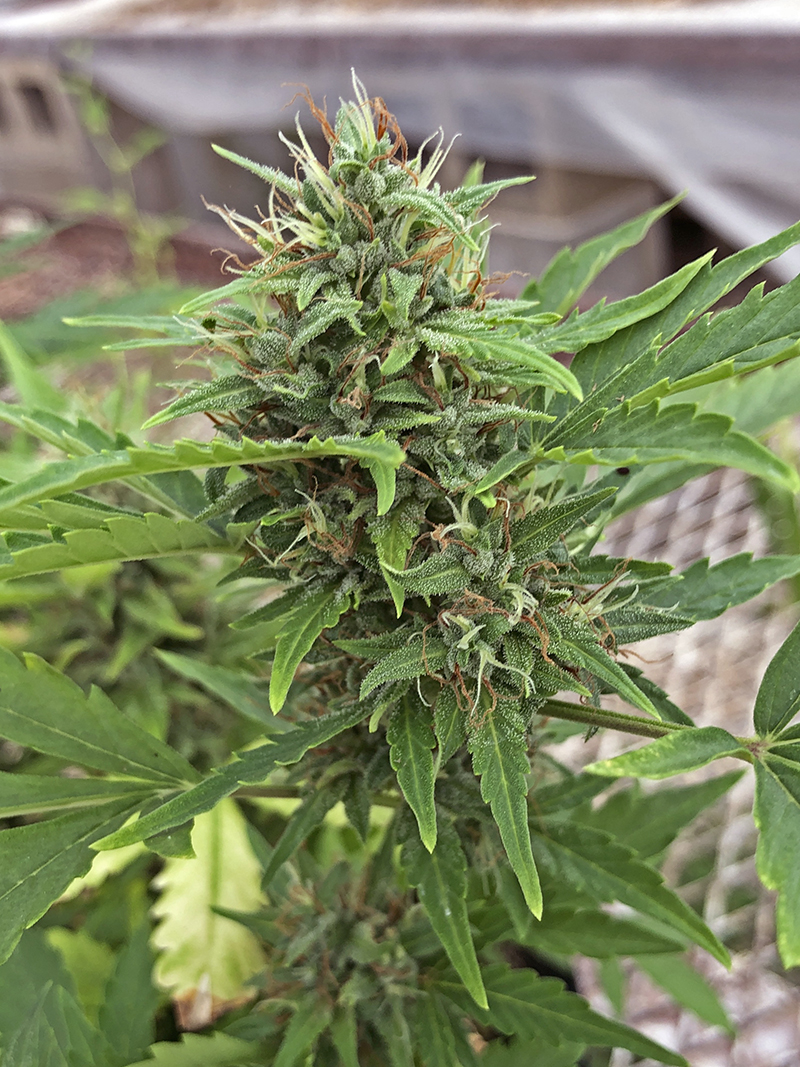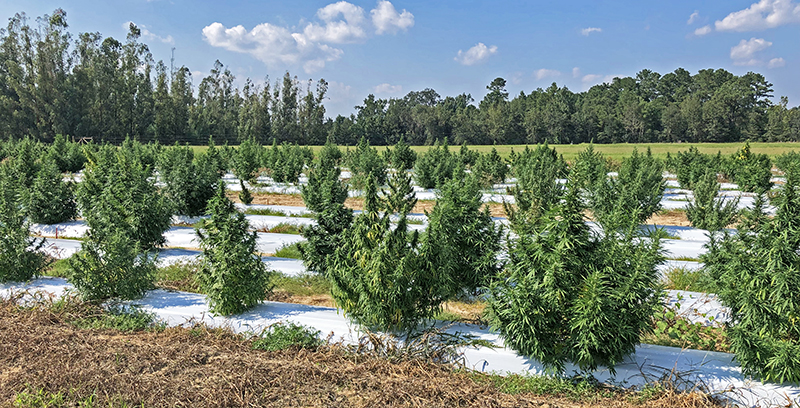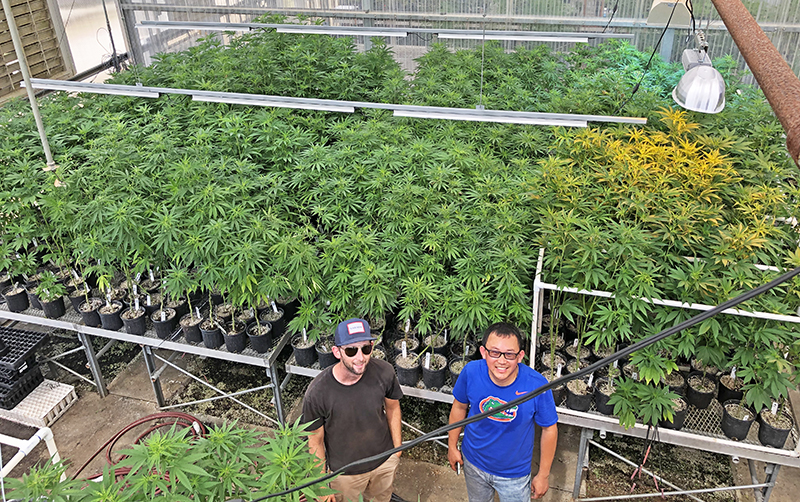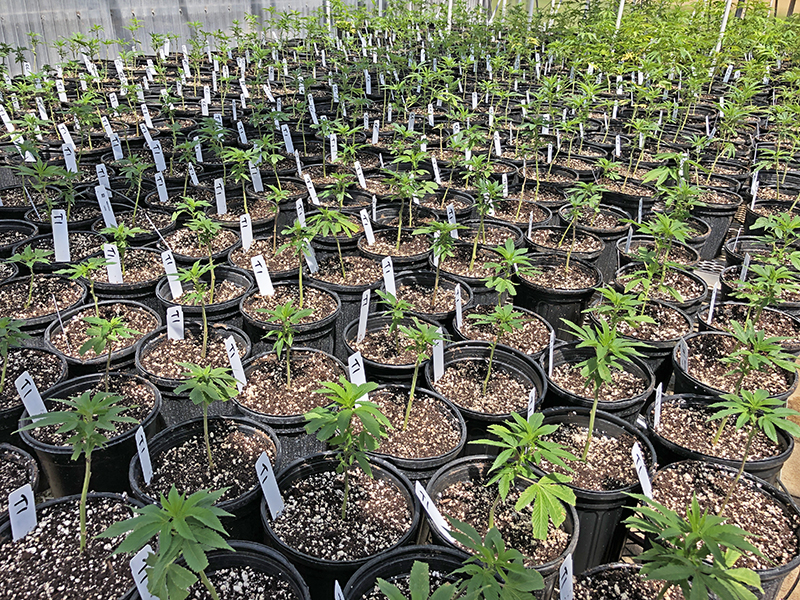Josh Freeman, Associate Professor of Horticultural Sciences, University of Florida, and Rui Yang, Post-Doctoral Associate, University of Florida

The female hemp flower can be harvested and processed to extract CBD oil. Credit: Josh Freeman, UF/IFAS
If you’re involved in agriculture, chances are you have heard about industrial hemp (IH) production in the last couple years. The 2014 Farm Bill authorized states to institute pilot programs which allowed growers to investigate the potential of producing hemp. Many states in the eastern US did this, including Kentucky, Tennessee, North Carolina, and South Carolina, among others. Industrial hemp is Cannabis sativa, the same plant species as marijuana. In fact, the two are visually indistinguishable. What separates marijuana and hemp is the delta-9-tetrahydrocannabinol (THC) content, the plant compound that is hallucinogenic. By law, hemp must have less than 0.30% THC per dry weight. There is currently some confusion surrounding testing for THC in hemp. Many pilot program states have set thresholds based on delta-9-THC. This is only a portion of THC in hemp plants. A significant portion of the THC is in the THC acid form (THCA) which subsequently converts to delta-9-THC when plant material is heated, dried, or aged. Interim final rules from USDA sets a threshold on total THC which is a combination of THCA (multiplied by a conversion factor of 0.877) and delta-9-THC. Based on USDA interim final rules, if hemp is found to be above this concentration in floral materials, it is subject to disposal.
Hemp is reported to have thousands of uses which include, fiber, human and animal food, and medicinal uses. In 2017, the Florida legislature approved SB 1726 which allowed land grant universities to conduct research on industrial hemp (IH) . The University of Florida Institute of Food and Agricultural Sciences (UF/IFAS) developed an IH pilot project, and information about the project and resources can be found at the following link: https://programs.ifas.ufl.edu/hemp/. The UF/IFAS North Florida Research and Education Center (NFREC) in Quincy was selected as a site for field research on IH. Because there has been such a large amount of time since IH was produced in the US, there are many unknowns related to its production.
Another significant unknown surrounding hemp are the rules that will govern its production. At this point, final rules have not been published by the Florida Department of Agriculture and Consumer Services (FDACS). Following is a link to the FDACS webpage that hosts information on regulations and permitting for IH production: https://www.fdacs.gov/Cannabis-Hemp/Hemp-CBD-in-Florida. This article is in no way a comprehensive review of potential IH regulations or a guide to its production, merely a primer and a list of resources for producers who may be interested in producing hemp. The information in this article is not meant to serve as recommendations, nor are any mention of variety names intended to be an endorsement.
–

Essential oil hemp variety trial raised on plastic mulch similar to commercial tomato production, at NFREC Quincy. Credit: Josh Freeman, UF/IFAS
Industrial hemp research began at NFREC during late spring 2019 with field plantings beginning in early July. Research efforts were focused on basic agronomic practices including planting date, planting density, variety selection, and harvest date. While work was conducted on grain/fiber IH varieties, most of the effort was concentrated on essential oil varieties and production methods. These varieties are grown with the intent to harvest female flowers and extract the oil from these flowers. This oil contains many compounds including cannabinoids [cannabidiol (CBD), and cannabigerol (CBG) are two examples] and terpenes which have many reported uses.
–

Hemp transplants for CBD oil production can be grown from seeds or rooted hemp cuttings from female plants , commonly referred to as clones. Credit Josh Freeman, UF/IFAS
–
–
A summary of the research conducted at NFREC in 2019 is included in the North Florida UF/IFAS Industrial Hemp Pilot Project 2019 Report . The research is still in its infancy, but has produced a significant amount of data that should be taken into consideration by potential producers. Variety trials resulted in flower yield that is comparable to, or greater than those seen by producers in other IH producing states in the southeast US. Our research also found that insect and disease pests can be prevalent on hemp. The data also suggested that currently used IH planting density in open-field production system for essential oil types (typically 1000-2000 plants per acre) may be too low. Results from NFREC indicated improved yield at plant populations much higher than are typically used. This study was planted on July 3rd, so it is important to note that if planting date was earlier or later in the season, the results may change because IH is a day length sensitive crop. Another critical factor that was evaluated in 2019 was the development of THC in IH flowers. Because THC concentration directly affects whether IH flower is legal and marketable, it should be monitored regularly. Our research was only based on 5 IH varieties so it should be noted that results may be different with other varieties or under different growing conditions. 2019 results showed that all IH varieties tested at NFREC went above the current 0.3 % THC threshold at full maturity (6-7 weeks post flower initiation). Some varieties subsequently dropped below threshold, while others remained above for the rest of the season. Because of the small nature of this experiment, its difficult to determine if this trend will be consistent across seasons and varieties, only more experimentation will answer these questions. It does however indicate that there is the potential of hemp varieties going above threshold and being potentially unmarketable.

Post-doctoral associate Rui Yang and Agricultural and Food Scientist Sawyer Maxwell in a greenhouse of stock plants at NFREC Quincy. Credit: Josh Freeman, UF/IFAS
–
There is still much to be learned about industrial hemp production in Florida, and whether this will become a viable alternative crop. As with any new crop, growers should understand the economic risks associated with IH production, and the markets for the end products before they invest in production. The regulations for IH production, which have not been finalized, will have a significant impact on the outcomes of production. Continue to monitor FDACS and UF/IFAS resources for future updates on hemp production and the UF/IFAS IH pilot project.
–
For more information on Industrial Hemp Production and Regulations in Florida, use the following links:
UF/IFAS Industrial Hemp Pilot Program website
Florida Department of Agriculture Hemp website
- NFREC Faculty Tribute to Arnie Forrester - February 11, 2022
- Tomato Varieties for 2022 - January 28, 2022
- Pumpkin Production in North Florida - July 30, 2021

